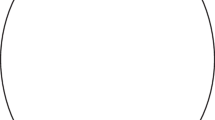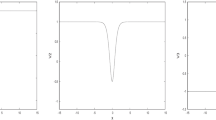Abstract
The theory developed in this paper shows that the propagation of spike potential along a nerve fiber and the conduction of an electric wave along an inert inorganic conductor follow a common quantitative relationship. This result gives further support to the belief that propagation of excitation is an electrical process. The basic idea of the theory is derived from the consideration that velocity has, by its mathematical definition, a local meaning; conduction in a nerve is completely determined by the local characteristics of the latter, as well as those of the wave. The final formula derived does not make use of any other field of science beyond the fundamental principles of electricity. It gives the conduction velocity in terms of the electric characteristics of the fiber and of the duration of the spike potential. The formula is in agreement with the known dependence of the conduction velocity on various parameters characterizing the axon. The computed velocity agrees with the measured ones on the squid giant axon, crab nerve axon, frog muscle fiber and Nitella cell. The membrane inductance appears as a velocity controling agent which prevents also a possible distortion of the spike potential during conduction. The structural meaning of the electric characteristics of the axon membrane is discussed from the viewpoint of the diffusion theory. A formula for the velocity of spread of the electrotonus is also derived.
Similar content being viewed by others
Literature
Arnell, N. 1936. “Untersuchung über die Dicke des Achsenzylinders und der Markscheide in nicht fixierten Spinalnerven des Menschen und des Hundes.”Acta Psychiat. et Neurol.,11, 5–25.
Auger, D. 1933. “Contribution à l'étude de la propagation de la variation électrique chez les Characées.”Compt. rend. Soc. biol.,113, 1437–40.
Bartlett, J. H. 1948. “Comparison of Transients in Inorganic Systems with those in Plant and Nerve Cells.”Jour. Cell. and Comp. Physiol.,32, 1–29.
Bear, R. S., F. O. Schmitt and J. Z. Young. 1937. “The Sheath components of the giant nerve fibers of the squid.”Proc. Roy. Soc. London,B123, 496–504.
Blinks, L. R. 1930. “The direct current resistance in Nitella.”Jour. Genl. Physiol.,13, 495–508.
Bogue, J. Y. and H. Rosenberg. 1934. “The rate of development and spread of electrotonus.”Jour. Physiol.,82, 353–68.
Cole, K. S. 1941. “Rectification and Inductance in the Squid Giant axon.”Jour. Genl. Physiol.,25, 29–51.
— 1947.Four Lectures on Biophysics. Rio de Janeiro: Instituto de Biofisica.
— 1949. “Some Physical Aspects of bioelectric phenomena.”Proc. Nat. Acad. Sci.,35, 558–66.
Cole, K. S. and R. F. Baker 1941. “Longitudinal impedance of the squid giant axon.”Jour. Gen. Physiol.,24, 771–88.
Cole, K. S. and H. J. Curtis 1938. “Electric impedance of Nitella during activity.”Jour. Gen. Physiol.,22, 37–64.
— 1939. “Electric impedance of the squid giant axon during activity.”Ibid.,,22, 649–70.
— 1940. “Membrane potential of the squid giant axon during current flow.”Ibid.,,24, 551–63.
— 1950. “Bioelectricity: Electric Physiology.”Handbook of Medical Physics (Ed. O. Glasser), Vol. 2, Chicago: Year Book Publishers.
Cole, K. and A. Hodgkin. 1939. “Membrane and protoplasm resistance in the squid giant axon.”Jour. Gen. Physiol.,22, 671–87.
Curtis, H. J. and K. S. Cole. 1937. “Transverse electric impedance of Nitella.”Jour. Genl. Physiol.,21, 189–201.
—. 1944. “Nerve: Excitation and Propagation.”Handbook of Medical Physics (Ed. O. Glasser). Chicago: Year Book Publishers.
— 1950. “Nervous system: Excitation and Propagation of Nerve.”Handbook of Medical Physics (Ed. O. Glasser). Chicago: Year Book Publishers.
Davis, L., Jr. and R. Lorente de Nò. 1947. “Contributions to the mathematical theory of the electrotonus.”Studies from the Rockefeller Inst. for Med. Res.,131, 442–96.
Davson, H. and J. F. Danielli. 1943.The Permeability of Natural Membranes. New York: Macmillan.
Eccles, J. C. 1948. “Conduction and Synaptic Transmission in the Nervous System.”Ann. Rev. Physiol.,10, 93–116.
Gasser, H. S. 1941. “The classification of nerve fibers.”Ohio. Jour. Sci.,41, 145–159.
Gasser, H. S. and H. Grundfest. 1939. “Axon diameters in relation to the spike dimensions and the conduction velocity in mammalian A fiber.”Am. Jour. Physiol.,127, 393–414.
Grundfest, H. 1940. “Bioelectric potentials.”Ann. Rev. Physiol.,2, 213–42.
— 1947. “Bioelectric potentials in the nervous system and in muscle.”Ibid.,,9, 477–506.
Grundfest, H. and H. S. Gasser. 1938. “Properties of mammalian nerve fibers of slowest conduction.”Am. Jour. Physiol.,123, 307–18.
Hill, S. E. and W. J. V. Osterhout 1935. “Nature of the action current in Nitella.”Jour. Gen. Physiol.,18, 377–83.
Hodgkin, A. L. 1939. “The relation between conduction velocity and the electrical resistance outside of a nerve fiber.”Jour. Physiol.,94, 560–70.
— 1947a. “The membrane resistance of a non-medullated nerve fibre.”Ibid.,,106, 305–18.
— 1947b. “The effect of potassium on the surface membrane of an isolated axon.”Ibid.,,106, 319–40.
Hodgkin, A. L. and W. A. H. Rushton. 1946. “The electrical constants of a crustacean nerve fibre.”Proc. Roy. Soc. London, B,133, 444–79.
Hursh, J. B. 1939. “Conduction velocity and diameter of nerve fibers.”Am. Jour. Physiol.,127, 131–39.
Katz, B. 1947. “The effect of electrolyte deficiency on the rate of conduction in a single nerve fibre.”Jour. Physiol.,106, 411–17.
— 1948. “The electrical properties of the muscle fibre membrane.”Proc. Roy. Soc. London,135 B, 506–34.
Kiss, F. and P. Mihálik 1928. “Über die Zusammensetzung der peripherischen Nerven.”Z. f. Anat. u. Entwickl.,88, 112–51.
Knowlton, E. A. 1949.Standard Handbook for Electrical Engineers. 8th Ed. New York: McGraw Hill.
Lloyd, D. P. C. 1947. “Principles of Nervous and Muscular Activity.” Textbook of Physiology (Howell-Fulton). 15th Ed. Philadelphia: W. B. Saunders Co.
Offner, F., A. Weinberg and G. Young 1940. “Nerve Conduction Theory: Some Mathematical Consequences of Bernstein's model.”Bull. Math. Biophysics,2, 89–103.
Opatowski, I. 1950a. “On Blair's theory of excitation and the role of internal energy sources.”Bull. Math. Biophysics,12, 123–33.
Opatowski, I. 1951. “On the mathematical theories of excitation.”Ibid. Bull. Math. Biophysics.13, March.
Osterhout, W. J. V. 1935. “Nature of the action current in Nitella.”Jour. Gen. Physiol.,18, 215–27.
— 1936. “Electrical Phenomena in Large Plant Cells.”Physiol. Rev.,16, 216–37.
— 1943. “Nature of the action current in Nitella.”Jour. Gen. Physiol.,27, 61–7.
Osterhout, W. J. V. and S. E. Hill. 1940. “Action curves with single peaks in Nitella in relation to the movement of potassium.”Jour. Gen. Physiol.,23, 743–51.
Pender, H. and S. R. Warren 1943.Electric circuits and fields. New York: McGraw-Hill.
Planck, M. 1890. “Über die Erregung von Electricität und Wärme in Electrolyten.”Ann. d. Physik. u. Chem.,39, 161–86.
Pond, S. E. 1921. “Correlation of the propagation velocity of the contraction wave in muscle with the electrical conductivity of the surrounding medium.”Jour. Genl. Physiol.,3, 807–26.
Pumphrey, R. J. and J. Z. Young. 1938. “The rates of conduction of nerve fibers of various diameters in Cephalopods.”Jour. Exp. Biol.,15, 453–66.
Rashevsky, N. 1933. “Some physico-mathematical aspects of nerve conduction.”Physics,4, 341–9.
— 1948.Mathematical Biophysics. Revised Edition. Chicago: University of Chicago Press.
Rosa, E. B. and F. W. Grover 1912. “Formulas and Tables for the Calculation of mutual and self-inductance.”Bureau Standards Bull,8, 1–237.
Rosenberg, H. 1937. “Electrotonus and Excitation in Nerve.”Proc. Roy. Soc. London, B,124, 308–36.
Rosenberg, H. and F. Schnauder. 1923. “Der scheinbare Widerstand verschieden langer Strecken und das Kernhüllenverhältnis des Froschnerven.”Z. f. Biol.,78, 175–93.
Rosenblueth, A., N. Wiener, W. Pitts and J. Garcia Ramos. 1948. “An account of the spike potential of axons.”Jour. Cell. and Comp. Physiol.,32, 275–317.
Rushton, W. A. H. 1937. “Initiation of the propagated disturbance.”Proc. Roy. Soc. London, B,124, 210–43.
Sanders, F. K. 1948. “The thickness of the myelin sheaths of normal and regenerating peripheral nerve fibres.”Proc. Roy. Soc. London,B135 323–357.
Sanders, F. K. and D. Whitteridge 1946. “Conduction velocity and myelin thickness in regenerating nerve fibers.”Jour. Physiol.,105, 152–74.
Schmitt, F. O. and R. S. Bear 1937. “The optical properties of vertebrate nerve axons as related to fiber size.”Jour. Cell. and Comp. Physiol.,9, 261–73.
— 1939. “The ultrastructure of the nerve axon sheath.”Biol. Rev.,14, 27–50.
Taylor, G. W. 1940. “The optical properties of the earthworm giant fiber sheath as related to fiber size.”Jour. Cell. and Comp. Physiol.,15, 363–86.
— 1941. “The optical properties of the shrimp nerve fiber sheath.”Ibid.,,18, 233–42.
— 1942. “The correlation between sheath birefringence and conduction velocity with special reference to earthworm fibers.Ibid.,20, 359–72.
— 1943. “Sheath birefringence as related to fiber size and conduction velocity of catfish, Mauthner Müller and peripheral fibers.”Ibid.,,21, 281–91.
Author information
Authors and Affiliations
Rights and permissions
About this article
Cite this article
Opatowski, I. The velocity of conduction in nerve fiber and its electric characteristics. Bulletin of Mathematical Biophysics 12, 277–302 (1950). https://doi.org/10.1007/BF02477900
Issue Date:
DOI: https://doi.org/10.1007/BF02477900




